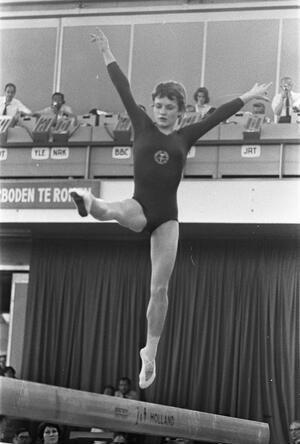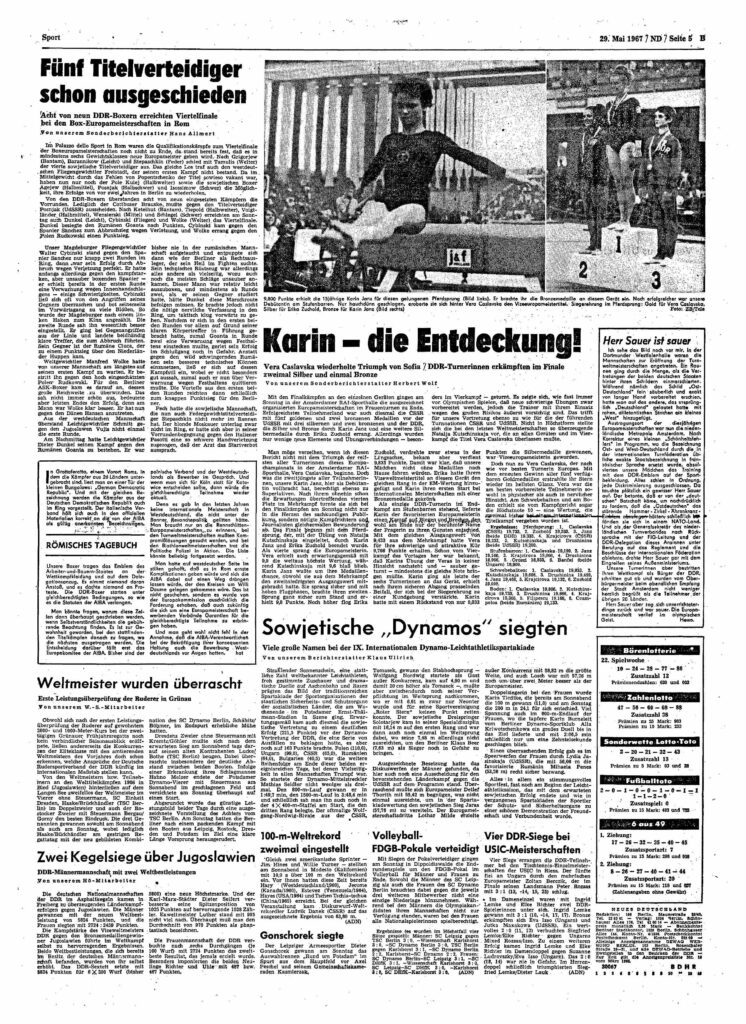Věra Čáslavská’s performance was the big news out of Amsterdam in 1967. But it wasn’t the only story.
15-year-old Karin Janz had an incredible international debut. In fact, she was just hundredths away from stopping Čáslavská’s gold medal sweep at the 1967 European Championships.
Let’s take a quick look at her performance…

Gymnastics Context | Video Footage | Crackling Applause: A Newspaper Account | So What?
Gymnastics Context
In the 1960s, a “new breed” of teenage gymnasts was competing against the veterans. (I dislike the term “new breed,” but that’s what gym nerds used at the time to describe teenage gymnasts.)
The term “new breed” primarily refers to the Soviet gymnasts who competed from 1965-1968, but by no means were they the first teenagers in international competition.
For example, Čáslavská won her first World Championships medal at the age of 16 in 1958. In 1964, Czechoslovak gymnast Marianna Krajčírová was 16 when her team won the silver medal, and the youngest gymnast at that Olympics was Jamileh Sorouri (14, IRI).
Here’s what was different about the “new breed:”
- The teenagers were coming from the Soviet Union
- The Soviet Union was considered *the* top team, and they had relied on gymnasts in their 20s and 30s for years
- The teenagers were beating the legends of the sport like Latynina and Astakhova
1964 Soviet Nationals
At the 1964 Soviet Nationals, 15-year-old Larisa Petrik defeated stalwart Larisa Latynina.
1965 European Championships
Months later, at the 1965 European Championships in Sofia, age trumped youth.
During her international debut, Petrik took home a bronze medal on beam, while Latynina won her last European Championship medals (four silvers and one bronze). And 23-year-old Čáslavská swept the gold medals.
1966 World Championships
In 1966, Čáslavská won the all-around title, but 17-year-old Natalia Kuchinskaya created a lot of buzz. She won silver in the team competition and individual all-around, as well as gold on bars, beam, and floor. She even made Čáslavská question whether she should quit the sport.
1967 European Championships
Čáslavská was golden once again, sweeping the all-around and every individual apparatus. But it was a 15-year-old East German gymnast who came the closest to stopping Čáslavská’s sweep.
During her international debut, Karin Janz was just 0.033 away from tying Čáslavská on the uneven bars, and by all accounts, her swinging stole the show.
Video Footage
Unfortunately, I haven’t found any extant video of Janz’s performances in Amsterdam. But I found a portion of her routine from the 1967 Little Olympics (Pre-Olympics Test Event), where she won the uneven bars title. (That competition will be the subject of another post in the near future.)
This clip gives you an idea of Janz’s skill level in 1967.
The hang time on her dismount is incredible!
Crackling Applause: A Newspaper Account
I unearthed this newspaper article from the May 29, 1967 edition of Neues Deutschland. What follows is a translation. You can read the original in German here.
—
Karin — A Discovery!
Věra Čáslavská repeated her triumph from Sofia [1965 European Championships] / GDR gymnasts won two silvers and one bronze in the apparatus finals.
The excellently organized European championships in women’s gymnastics came to an end on Sunday with the apparatus finals in Amsterdam’s RAI Arena. Once again, the most successful country was Czechoslovakia with five gold and two bronze medals, finishing ahead of the USSR, which won three silver and two bronze medals, and the GDR, which won silver and bronze from Karin Janz and another silver medal from Erika Zuchold. Only a few new elements and connections — especially in the all-around — were performed. It demonstrated, as almost always happens before Olympic Games, that new difficult exercises are prepared; however, the coaches are extremely cautious with their use because of the great risk. This is true for our representation as well as for those of the leading gymnastics nations CSSR and USSR. Natalia Kuchinskaya, who was so convincing at the last World Championships, was not in top form and left the titles to Věra Čáslavská on all apparatuses and in the all-around.
One can forgive me if I do not begin this report with the triumph of Věra Čáslavská, the most experienced of all gymnasts of the European championship in the Amsterdam RAI Arena. But what the second youngest of all participants, our Karin Janz, achieved here as a debutante, also justifies superlatives. After already exceeding expectations by placing fourth in the all-around, she not only worked her way into the hearts of the knowledgeable audience at the finals on Sunday, but also won admiration from judges and journalists alike. The final began with vault, which started with Natalia Kuchinskaya and ended with Karin Janz and Erika Zuchold. The European champion [Věra] vaulted fourth. As expected, Věra received by far the highest rating with a 9.9, while Kuchinskaya paled in comparison with a 9.6. Karin Janz knew she had a chance for a medal, although she qualified for finals with the second-lowest starting value from the all-around competition. She vaulted assuredly/safely and with high flight phases, stuck her second vault, and received a 9.8. Erika Zuchold flew even higher, twisted a little, but earned 9.833 points. This made it clear that our girls would not go home without medals. Erika followed up her silver medal on vault at Worlds with a silver on the same apparatus at the European Championships, and Karin made her international debut with a bronze medal.
As the only GDR gymnast who qualified for the uneven bars final, Karin fought the favored European champion by all means possible, and in the end, only the famous woman from Prague finished ahead of her. During apparatus finals, Věra had received a 9.766 for her difficult and attractive routine. Since both gymnasts scored 9.433s during the all-around competition, it was already known that Karin’s routine was in no way inferior to Věra’s and — if performed properly — it should receive at least the same score. Karin was the last of the six gymnasts to go on the apparatus and, after her safe dismount, received crackling applause, which was strengthened at the award ceremony, Karin, who won the silver medal by a margin of only 0.033 points, won silver.
Now to Věra Čáslavská, who is still the best gymnast in Europe. By winning all five available gold medals once again, her star shone the brightest once more. Věra was the best-prepared participant, both physically and mentally. On the balance beam and on the floor, she even received the highest score — a 10 — from the judging panel — a rating that has now been awarded twice in an international competition.
(Thanks to Kensley for the translation assistance.)
—
Note: Non-East-German newspaper accounts confirm that Janz received quite the ovation for her bar routine. The line about the “crackling applause” wasn’t simply a nationalistic perspective.
The Dutch newspaper Utrechtsch Nieuwsblad said:
15-year-old Karin Janz from East Germany got a thunderous ovation for her routine on the uneven bars. Her score: 9.733. Only 0.033 behind Věra. The judges had to express the difference in thousandths.
So What?
Why does this matter?
Janz: Often Overlooked
When we talk about the rise of teenage gymnasts in the 1960s, most of the focus falls on Natalia Kuchinskaya, Larisa Petrik, Zinaida Druzhinina, Ludmilla Tourischeva, and even Cathy Rigby.
Karin Janz’s early years, on the other hand, get lost in their shadows.
The 15-year-old made her international debut at the European Championships, and between the competition in Amsterdam and the “Little Olympics” in Mexico City, she had an impressive debut — one that deserves more fanfare.
Writing History through the Eyes of the Winners
When we write sweeping histories of women’s artistic gymnastics, we often tell the histories of the victors. We look at the Soviet Union, Romania, Russia, and the United States.
As a result, countries that haven’t won multiple team gold medals or all-around gold medals are left out.
East Germany, though successful, is one of those ignored countries.
This post is just a small tribute to Karin Janz’s — and, to a lesser degree, East Germany’s — legacy.
The German Original

Karin — die Entdeckung!
Vera Caslavska wiederholte Triumph von Sofia / DDR-Turnerinnen erkämpften im Final zweimal Silber und einmal Bronze.
Mit den Finalkämpfen an den einzelnen Geräten gingen am Sonntag in der Amsterdamer RAI-Sporthalle die ausgezeichnet organisierten Europameisterschaften im Frauenturnen zu Ende. Erfolgreichstes Teilnehmerland war auch diesmal die CSSR mit fünf goldenen und zwei bronzenen Medaillen vor der UdSSR mit drei silbernen und zwei bronzenen und der DDR, die Silber und Bronze durch Karin Janz und eine weitere Silbermedaille durch Erika Zuchold errang. Allerdings wurden nur wenige neue Elemente und Übungsverbindungen — besonders im Vierkampf — geturnt. Es zeigte sich, wie fast immer vor Olympischen Spielen, daß neue schwierige Übungen zwar vorbereitet werden, jedoch die Trainer mit ihrem Einsatz wegen des großen Risikos äußerst vorsichtig sind. Das trifft für unsere Vertretung ebenso zu wie für die der führenden Turnnationen CSSR und UdSSR. Nicht in Höchstform stellte sich die bei den letzten Weltmeisterschaften so überzeugende Natalja Kutschinskaja vor, die an allen Geräten und im Vierkampf die Titel Vera Caslavska überlassen mußte.
Man möge verzeihen, wenn ich diesen Bericht nicht mit dem Triumph der reifsten aller Turnerinnen dieses Europachampionats in der Amsterdamer RAI-Sporthalle, Vera Caslavska beginne. Doch was die zweitjüngste aller Teilnehmerinnen, unsere Karin Janz, hier als Debütantin vollbracht hat, berechtigt ebenso zu Superlativen. Nach ihrem ohnehin schon die Erwartungen übertreffenden vierten Platz im Mehrkampf turnte sie sich bei den Finalkämpfen am Sonntag nicht nur in die Herzen des sachkundigen Publikums sondern nötigte Kampfrichtern und Journalisten gleichermaßen Bewunderung ab. Das Finale begann mit dem Pferdsprung, der mit der Übung von Natalja Kutschinskaja eingeleitet, durch Karin Janz und Erika Zuchold beendet wurde. Als vierte sprang die Europameisterin. Vera erhielt auch erwartungsgemäß mit 9,9 die weitaus höchste Wertung, während Kutschinskaja mit 9,6 blaß blieb. Karin Janz wußte um ihre Medaillenchance, obwohl sie aus dem Mehrkampf den zweitniedrigsten Ausgangswert mitgebracht hatte. Sie sprang sicher und mit hohen Flugphasen, brachte ihren zweiten Sprung ganz sicher zum Stand und erhielt 9,8 Punkte. Noch höher flog Erika Zuchold, verdrehte zwar etwas in der Längsachse, bekam aber verdient 9,833 Punkte. Damit war klar, daß unsere Mädchen nicht ohne Medaillen nach Hause fahren würden. Erika hatte ihrem Vizeweltmeistertitel an diesem Gerät den gleichen Rang in der EM-Wertung hinzugefügt und Karin ihren ersten Start bei internationalen Meisterschaften mit einer Bronzemedaille gekrönt.
Als einzige DDR-Turnerin im Endkampf am Stufenbarren stehend, lieferte Karin der favorisierten Europameisterin einen Kampf auf Biegen und Brechen den wohl am Ende nur der berühmte Name der Pragerin zu ihren Gunsten entschied. Mit dem gleichen Ausgangswert von 9.433 aus dem Mehrkampf hatte Vera für ihre schwierige und attraktive Kür 9,766 Punkte erhalten. Schon vom Vierkampf des Vortages her war bekannt, daß Karins Übung der Veras in keiner Hinsicht nachsteht und — sauber geturnt — mindestens die gleiche Note bringen müßte. Karin ging als letzte der sechs Turnerinnen an das Gerät, erhielt nach ihrem sicheren Abgang prasselnden Beifall, der sich bei der Siegerehrung zu verstärkte. Karin mit einem Rückstand von nur 0,033 Punkten die Silbermedaille gewonnen, war Vizeeuropameisterin geworden.
Doch nun zu Vera Caslavska, der nach wie vor besten Turnerin Europas. Mit dem erneuten Gewinn aller fünf verfügbaren Goldmedaillen erstrahlte ihr Stern wieder im hellsten Glanz. Vera war die am besten vorbereitete Teilnehmerin sowohl in physischer als auch in nervlicher Hinsicht. Am Schwebebalken und am Boden erhielt sie kom Kampfgericht sogar die Höchstnote 10 — eine Wertung, die zweimal bisher bei einem internationalen Titelkampf vergeben worden ist.